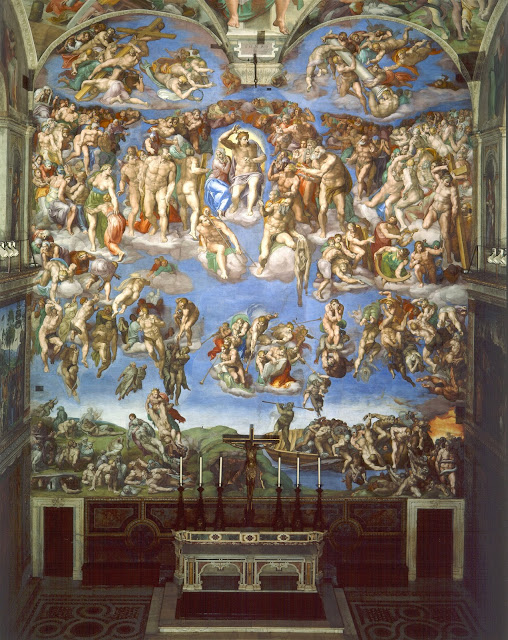 | ||
| Pontormo Deposition from the Cross 1528 |
Mannerism or
Maniera is considered a late style of the sixteenth century.
The group of artists working in this way were mainly influenced by
High Renaissance master Michelangelo. “Michelangelo's authority
impressed a sculptural example on Maniera painters, not only in his
works in stone but by his sculpturesque painting” (Freedberg, 287).
Raphael is also considered an influence because "in his last and
most influential years, [took a] sculpturesque cast into his art
[which] tended to dictate a stressed plasticity” (Freedberg, 287).
Artists like Michelangelo influenced mannerists due their
sculpturesque styles (plasticity) as stated by Freedberg “the
hard-surfaced, plastically emphatic form of many high Maniera
pictures, which has so large a part in this effect, comes often from
the deliberate imitation of a sculptural style” (287).
Maniera has "problems" in that it is not drawn from
life or nature. It was after the artist “Raphael [that] there was
suddenly a decline. Artists abandoned the study of nature, corrupted
art with la maniera or, if
you prefer, a fantastic idea based on practice, and not on the
imitation [of nature]” (Smyth, 22). In the “mid-sixteenth
century, painters of [the] day were using the word maniera
derogatorily in connection with
painting in which one saw forms. Faces, and (by implication) bearing
and movements that were almost always alike” (Smyth, 35). It must
be this extreme dislike of the style since it's beginning that it has
become so controversial and no longer included in our History
of Italian Renaissance Art.
Freedberg, in fact, did not like the
term Mannerism or Maniera (but used them anyway), he much preferred
to classify this style of art as "anti-classical". This
makes sense because of the properties of the particular style are
somewhat the antonym to the High Renaissance which was classically
based. Maniera painting has characteristics of sculpturesque
modelings or plasticity, elongated figures, extreme detail, angular
poses, and is created usually by examining other artwork (not
directly from life). “More
pervasive are the principles of angularity and of spotting the
composition with angular elements. Elongation is not central to
maniera, but these two
conventions are” (Smyth, 43). Maniera painters considered
“line, modeling, and color in
painting di maniera [to
be] better suited to serve a uniform ideal than nature's variety”
(Smyth, 49).
However, “Maniera painting
is an art of figures, as most central Italians thought painting
should be” (Smyth, 49). The emphasis on grace and elegance in this
style correlate to the word maniera,
which "has an old association with style" (Smyth, 98). Some
believe mannerism to be a decline in Florence and Rome after 1530 or
1540, the monotonously uniform figures could be easily disregarded.
However, according to Smyth, “not only is Mannerism now considered
valid for the Cinquecento, but it also begins to be applied as the
name for a subjective, surrealistic, anticlassic phenomenon that
critics see recurring in European art.” (Smyth, 98-99)
I
find the work of Mannerism exciting, the strange color schemes and
weird figures are refreshing. I think mannerism is still a style
sought out today. Contemporary artist John Currin must be inspired by
this period of art, as well as the Pop Surrealist movement. Pop
Surrealism correlates to the surrealistic characteristics of
mannerism. I look forward to learning more about mannerism is class,
and if others agree that mannerism is still influential today. Maybe
more influential than the High Renaissance?
 |
| Lori Early LEILA oil on board 2007 (Pop Surrealist) |
 |
| John Currin The Old Fence 1999 |
 |
| John Currin Thanksgiving 2003 |






















